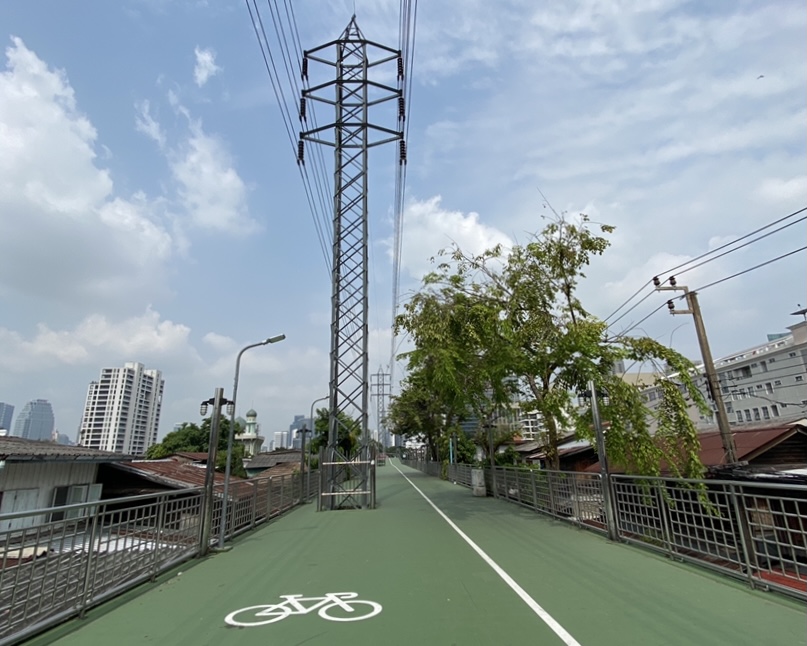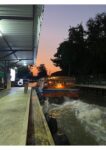Cover Photo: Public Walk Link Lumpini-Benjakitti Park by Nutt.t
Volume 6, Number 2: May 2021 | Op-ed
Believe it or not, Thailand has invested in cycling infrastructure. In 2008, a bicycle lane project was introduced in Bangkok. The plan involved creating over 230 kilometers worth of bicycle lanes all over the city. By 2017, the Thai government has invested over 28 million baht into the project. The results? Underwhelming. A second try was attempted in 2012 with the introduction of the “PunPun” bike sharing program. Fifty stations, each with eight bicycles, meant that 400 rental bikes were available all over central Bangkok. However, the adoption of the program is also disappointing (As of writing this piece, the official website: www.punpunbikeshare.com is down). However, despite these past failures, I believe that Bangkok is ready for a third attempt at promoting cycling as a viable method for traveling in the busy city. This will be done by examining the previous attempts at promoting cycling in Bangkok.
Bicycle Lanes in Rattanakosin Island Area Development Project
When the project was first introduced in 2007, it was popular as the citizens of Bangkok were looking for an alternative method of transport aside from the cars. However, its execution can only be described as rushed and unthought-out. By the end of the project, the organisations responsible deemed the expansion project as a failure. Many problems have been identified which continue to obstruct the use of bicycle lanes.
Firstly, there are many problems with the infrastructure themselves. Apart from the food stalls and parked cars, there are obstacles from the foundation of the bicycle lanes. Some of the lanes are converted from existing roads, taking space that used to be for cars. However, there is no clear barrier between the motorised and non-motorised vehicles apart from the paint on the road. And as mentioned in the previous paragraph, little respect is found from the drivers. Alternatively, some of the bicycle lanes were converted from the pedestrian walkway. However, this posed even more problems. There is the common problem with uneven tiles which risk tripping cyclers. Furthermore, there are even more obstacles on the pedestrian walkway including trees, utility post, and most surprisingly, traffic poles. The poles were put in place as a way to deter motorbikes from using the bicycle lanes, however, it had the unintended (but expected) effect of also deterring non-motor bikes. Either way, the bicycle lanes were unfriendly to cyclers wherever they were placed.
Secondly, the bicycle lanes tend to be misused. A major issue with the bicycle lanes is that they are not being used by cyclers. Instead, the path is populated by food stalls or repurposed as a parking spot for motorised vehicles. This is not new. Even without the bicycle lanes, cars and motorbikes can already be found parked along the road despite it being illegal. There seem to be a problem with the attitude some Thai drivers have towards traffic law and regulation. Moreover, the food stalls could not be blamed either. Some were established there long before the bicycle lanes were and they are not willing to move away.
Lastly, the lanes are disconnected from other public transports. As a non-motorised bike requires some physical work, the distance that can be covered is limited. If a Bangkokian needed to travel longer distances, they may still resort to the car. To achieve full adoption of the bike lane, they should facilitate easy accessibility to other public transports, especially the skytrains.
PunPun Bicycle Share Program
This program allowed for the average Bangkokian to rent a bike for use in the city. There are many positives going for it. For one, the rental stations are generally located in front of public transport stations. This is an improvement from the previously mentioned point. However, the roadblock for this program is the busy roads of central Bangkok. Without a designated path to cycle on, the Bangkok roads are generally unfriendly to cyclers. Alternatively, the sidewalks may even be more difficult to cycle on given all the obstacles to an average pedestrian (as described in the previous section).
In sum, the biggest issue that stops the adoption of cycling in Bangkok is:
“Cycling in Bangkok is too Dangerous”
So why do I believe that it is time for the third attempt?
The bike sharing infrastructure is already there, now it is time to make it a viable option. I believe that the combination of the two previous programs can facilitate this. I propose that the next step is to introduce bicycle lanes that connect each PunPun station. This will involve converting roads and sidewalks to make room for the bicycle. A full plan for this requires more research and planning that is out of the scope of this article but it is important to keep in mind the problems with the original bicycle lane project.
The original plans reflected a lack of research, communication, and regulation in the establishment of the bicycle lanes. The worst offender may be the lack of enforcement of traffic laws in Bangkok. It has been cited that a lack of manpower was the root cause of this widespread epidemic. This reminded me of another traffic problem in Thailand where motorbikes were illegally on the pedestrian walkway. The smart decision from the regulators was to move that responsibility to the average citizen by providing a cash incentive to report the motorbikes that are on the sidewalk. I believe that a similar policy could be implemented in regulating the new bicycle lanes. Given that these lanes will be on busy roads populated by both cars and pedestrians, I believe that this policy will be very effective in regulating itself.
This program will not be cheap; it will face backlash from those involved in the previous failed attempts; and it will definitely face some resistance from the numerous users of the roads in Bangkok. However, I remain optimistic given the more environmentally conscious populous and the rising popularity of cycling in Bangkok. I truly believe that the roadblocks to cycling in Bangkok are fixable and that full adoption is achievable within the next decade.
Reference
- Bunluthangthum,N. (2013). How to use Bangkok’s Pun Pun Bicycle Sharing System. Retrieved from: https://bk.asia-city.com/city-living/article/guide-bangkok-pun-pun-bicycle-sharing-system
- Mokkhasen,S. (2017). Report A Moto On Sidewalk And Get Paid Half The Fine. Retrieved from: https://www.khaosodenglish.com/news/bangkok/2017/04/17/report-moto-sidewalk-get-paid-half-fine/
- Shady,T. (2017). Pun Pun Bicycle Share Program in Bangkok Thailand. Retrieved from: https://bicyclethailand.com/pun-pun-bicycle-share-program-in-bangkok-thailand/
- Owen,U. (2017). Bicycle lane projects in Bangkok have wasted 28 million baht in 9 years. Retrieved from: https://bicyclethailand.com/bicycle-lane-projects-in-bangkok-have-wasted-28-million-baht-in-9-years/












































I do agree with all the points that you have made. Biking in Bangkok just sounds like a dangerous activity due to the lack of infrastructure that can protect the cyclists and the numbers of cars and motorbikes on the road are just too much. In my opinion, a better location to start out for this type of project again would suit the area around Asoke to Thonglor or Ekkamai as the traffic is not as bad as the Pun Pun stations and so many people walk on the sidewalk. I believe that with proper bike lanes and safety, we would be able to see more cyclists on the road.
The main road along Asoke-Ekkamai is an interesting area to develop cycling infrastructure. The area is filled with interesting places to go to, living spaces, offices and (most importantly) loads of cars. Perhaps this is a viable trial to have in order to test out the design and justify its expansion in the rest of Bangkok.
I will totally support the idea of bike sharing infrastructure. Although biking sharing program might cost a lot money and resource in terms of developing a new application, distribution of bikes and so on, the sharing economy is still beneficial to the society and environment. If there’s dozens of bikes distributed in different areas of Bangkok, pedestrians would have more choices while walking in the Bangkok city. They could enjoy their journey by either walking or cycling while neither of them would bring pollution to the society. However, the danger of ride a bicycle might be depending on the structure of road lanes. If there’s a special lane for cycling on the road, it could be occupied by motorcycles and cars. Anyway I wish I could see shared bikes somewhere in Bangkok in the future.
I do agree on all the points you mentioned! I also see that Thailand still have hope for the bike lanes. You have mentioned about the lack of infrastructure to protect cyclist, and if Thailand were to construct again, I do agree than a better protection infrastructure is needed. However, I think we also need to work with ‘mindset’ as well! Including car drivers, sellers that use walkway as their store, motorcyclist, and the cyclist themselves. Campaign on educating all of them to understand the purpose of bike lanes is crucial! And it has to go along with an effective government implementation of laws and regulations to promote bike lanes. I agree with the comment before that we could start from a specific area where it is easier to implement like Asoke, Thonglor and Ekkamai area. This could be a good start for all Thais to understand the usage, purpose and consequences of bike lanes.
Driver’s mindset is an interesting thing to look at, especially in Bangkok. Our motorcyclists seem to consider the sidewalk as free lanes for them; delivery trucks seem to just park where ever they want to drop off their load; and taxis have a tendency to be reckless. Sadly, I believe this comes down to a lack of regulation from the traffic authorities. If these behaviours were punished accordingly, perhaps we would achieve a friendlier road network fit for cyclers.